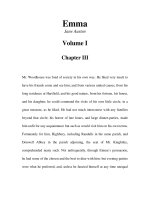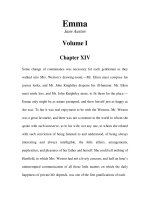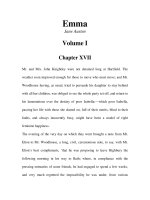Los alamos technical series volume i, experimental techniques part II ionization chambers and counters section b
Bạn đang xem bản rút gọn của tài liệu. Xem và tải ngay bản đầy đủ của tài liệu tại đây (7.9 MB, 256 trang )
-.
—.-
—
*
APPROVED FOR PUBLIC RELEASE
uNCIAJS/F/ED
1
CLASSJFICATIOIJ
CMWELLED
For The AtoQ& lkxgy Commisson
by tie Declassi[icatioRCWer
Pdhk&+x~
7:
S!!!!
,
PUBLICLY
Per ~@SS‘
Rl?LEAS~LE
16 Date;
‘
LA-
//-Y-?.
CIC- 14 Date: Z.
zz-~=
10CL
This document contaks~ges
October 28, 19)46
vOL. I EXPEXIMENTAL Ni’CmIQUM
‘‘
Part II Ionization Chambers and Counters
Section B
Written By:
Bruno Ros8i
Hana Staub
4
gm~:.,..
-..——
1-
1“-=-—
_.:—-—.
. #
-~%.-
CLASSIFIER
..
!,...
---
APPROVED FOR PUBLIC RELEASE
.,-
-_.. . .
----,-.
~
.>.4-<
.,. .
-.
APPROVED FOR PUBLIC RELEASE
!.
.
.
UNCLASSIFIED
!.
LOS ALAAK)STNCHliIC& SERIES
This is copy—.
.“
.
.. .
,.’
,.
..
:.
,.
,,
,.
,.
,
‘.
,-
,-
,’
.,
,,
#
.
*
!-..
APPROVED FOR PUBLIC RELEASE
..1
of—
Copjes
.
. ..,.,. .. ,-..
APPROVED FOR PUBLIC RELEASE
..
.-, ,..
,
.“*.
. .. .
..”
.
UNCLASSIFIED
?MNHATTAN PRCd?kT TECHNICAL SLRD3S
..!
$
‘“.
,-.’ i,”--’;.’
“’ .. .> -,,.-...:
L
--,.. . .,. +,.,..
.,,.. ..-........,.<..->
. .’
,.
,
,. .... .
,,
. . . .-,
. .
..
.“ “. -. ‘.”,
. ,’ .
... . .. .. ,.
..,.. ... .,:...
,,.,”
,. -,. :. ..-.
.
,,
-,,-
-.
●
‘CONTi-t.IIWTIOIJ
OF
LOS AM&AS
PROJECT
.
——
●
●
7,. .
The following material may tw subject
.
to certain rfixlor
revisions in the event that”
.
factual errors are discovered previous to
final publications Gf this pa%
Series.
d~ny
of the Techni&d.
usual manner.
a
,.UNCLASSIFIED
m
APPROVED FOR PUBLIC RELEASE
,. .—
.
..
,.
.
. .
.. . -.
‘,
such cktn~es will be submit%ed for
p~tent cle~rance and declassification in the
-.
t..
.
...
,
.’,,
.’”,
..... ,-,
. . .
.. :
.. .
...., .
..
..*
,
. “*.
. -“ ..-.
,..
., ,.Z
.. . ... ,--.*,,
r
... ......<.
>,
... ,, ,;”
,:... :.,:
.... ;:.
. -u:
.
.
.
...
‘,
.,. . ,:
.
,..~
.-:
--..
..-..,
.
- .. - ,-,.
,..
.:.--. .,,
. . .. .’.”
:
:..,, .-.;;..;;,
....-....’
.“ .,---.“ .4 ,. ~“,.,
.
t.’.
. .“.
:...
.
.
,.’ -.... .,.
. ...-. .
--.’
, ..... .
APPROVED FOR PUBLIC RELEASE
.
UIVC[A5JIFIED
2ZFFX1W:TAL
TEKHNI\;
ll&
-. .._
UNCLASSIFIED
APPROVED FOR PUBLIC RELEASE
APPROVED FOR PUBLIC RELEASE
I
ALPHA PARTICLE ULTEJJ’IWS
13.1
ALPHA PARTICLE SPIiClliOSCOPY
In mcst cases of interest tl_.e
source of d -particl- iS used in solid
form. consequently the material under investigation is depcsited as a thin
filfr..If one is intereshd in the energy distribution, the detector has to
be constructed so tkaL, regardless of tiieir@nargy, al] of the
particles spend tk,eirentire range in the detectcr and also that the height
cf the pulses has a known relation ta the particle energy. Suppose a thin
fik
of active material is deposited on one of the electrodes of a plane
parallel plate chamber, such that no d-- particle escapee from Lktecounting
v dume ,
If the chamber is Operated as an ion pulse chamber, the vclWge
rise of the collecting electrcde resulting frcm every particle will
be direct-
ly proportional to its energy, regardless of the direction of emission
(assurnirlg,
of course, conatincy of the value of the average energy spent
per ion pair]. If the chamber is operated as an electrcn pulse c!.amber,the
pulse height is proportional to 4; .
“ For ~-par~icles originating at the negative electrode b; is given by
where No is the total number of ion pairs produc~d by and-particle$
;
is
tk,edietance of the center of gravity of ionization frca the origin of the
tra.ckand @
tie angle betwew, tl~etrack and tk.eperpendicular electrcde
(See Section 10.5), Since for an isobrcpica.llyemi~ting source} the number
*
of particles emitkd
between
@
and @4- d~
is proportional to sin@
tho mxnber Or pdses with height beLween P and Y+&
:. —,,
APPROVED FOR PUBLIC RELEASE
iS giVe~
by:
d~
,
APPROVED FOR PUBLIC RELEASE
15’7
f{I’) dP
=
(conet.) sin ~
d~
...
~
~d
P are connected by (1) considering that P is proport.ior,al
to Q-0 .
Therefore
dp
and
n (~~n~t.) d(e~~@
)
(2)
f(P) = (con8t.)
‘he curve representing f[P) is called the differcmtial pulse heigh~ distribution.
Equation 2 shows that for the case under consideration f(P) is a ccnstx%nt
between F=
and Ptinwheret
(3)
,
‘ItIe
pulses of size Ffin correspond to particles emitted perpemticularly to the
electrode; those of size Fmax to particles emitted para31el to the electrcdeo
he relative spread of the pulse sizes depervisonly on the ratio of electrode
*
9eparaLion to particle range and tilestop])ingpower of tk.egas used.
In Section A.1
(see Appendix to Part.11)
the value of=
functior,of the cL-particle energy for various gaees.
mental di9Lributions measured w~.th M-particles
is given as a
In Figure 1 two experi-
from polonium are shown, to-
gether with the +,heoreticallyexp~ted curnms. ‘fite
finite differential resolution
of the detectcr was taken irj~oaccount. ‘IIJis
is tie reason for the finite
slope of the U]eor&tjcal curves at Pm&
and F,Din.
Fran the foregoing, it is obvious that the use of plane parallel chambers
with electrc.ncollection for d.-particle spectroscopy would offer great
difficulties in the interpretation,Gf tl,eresult, since every ILonochrGmt.ic
a-line
would show up as & my~.iredist.rimticn of p’ulses. ‘foavoid thi9
difficulty, cne can insert a screening grid electrcde between the collecting
and hjgh voltage electrodes. As described iriSection 10.2, the grid electrode,
which is
placed so far frcw the negetive s16cWOW
(carrying the CX-particle
APPROVED FOR PUBLIC RELEASE
APPROVED FOR PUBLIC RELEASE
158
Figure 1
APPROVED FOR PUBLIC RELEASE
*
8
.
t
●
.—
—
*
I
- . .—
.—
g
--
APPROVED FOR PUBLIC RELEASE
*-
k
9NllN~09
---
+ H-— ,
-
i.#4*
.
I
-. --
-—
i
I
.1
I
.
~
- .-.----
!
.—
.
--
)<+—
—
.
.-— .—
.—.-—
- ..— -..—
H
---+
~ Ou+J
—
.
-~~
——
$
.—
_. .——-.._—
,.-
. .. ...—- ..___. ..... . .. .. -—. ———..-— . .
I
—
PX 4
.-.
-
—— { ..
-—..-—
—-—
I
-
...—— - .——. —--
x 1.
—.
+-x
x
.—
g3A
2s
I
i=
(.s3
m“ ~Y
Q- ~
al ma
WLI
CL
00
Zzw
tiiig
:pg
U) (nt* t-x-l
0
0
31VEI
APPROVED FOR PUBLIC RELEASE
)x+
-
“
0
Q
0
“0
b+
0
r
m
II
w
Uj
or
u)
+x+--
2
m
S
o
‘ml
0
-m
0:
d-d
i!
(K
w
>
--- _g
w
.—
—
——
Jo
0
APPROVED FOR PUBLIC RELEASE
source) that it i6 not reached by the ~-par iicles, shields the collecting
electrode frcm the field of the positive ions remeining after the Ccmplete
collection of ti;eelectrons. Gonbequently$ the [Iulsesobserved are all equal
and proportional
Lo l~o, l%e coristructionof a grid chamber used far cL-particle8
is shown in Figure 15.12.
of the J. -source
Ihe nega~.iveelectrc.de,carrying the thin deposit
was kept at
the grid electrcde at -1250 V.
-25~
V with respect to the collector ad
It is rather important for good resolution
that,the grid is at a relatively nigh negative pctential with respect tc the
collec~or. lllevoltage ketween grid aridnegative electrode cm
be small.
It should only be hi.~hencugiito prevent recombination or attachment of tie
electrGns. ?he high vol~age between grid and positive electrode tends to
reduce
the spread in the sizes of the d-.=rticle pulses since the higher
field in the neighborhood of the grid lowers the probability for capture
of the electrone by the wires.
maximum of transparency in oraer
The grid is cc.:lstructed
so as to give a
to make the fractioriof electrons CapLured
by Lklewires as small as pOssib10. It consists of 3 mil diameter parallel
steel wires, spaced 1/16 inch apart.
‘fitka chamber filling of 7.5 ~tm. argon, and a normal sample of uranium
(U-2~in
equilibria, witl,U-238), tttedifferential pulse heighbdistributi.on
given in Figure 2 was obtained. It Mows
the t~ogroaps of ti-partioles well
resolved and of about the same ti,LefisiLy.The width of ~he peaks is only
slightly larger than the charmel width of ~he detector as indicated M
the
figure.
It may be poin~d
out thaL spectral distributions could also quite con-
veniently be determir.edby accurate range aeasurernents. However, it was fcund
that the results obtair.edby the above described pulse height method showed
*,
considerably better resoluL.ion,sirme the straggling in range has no eifect on
.
the pulse size.
APPROVED FOR PUBLIC RELEASE
APPROVED FOR PUBLIC RELEASE
iliO
Figure 2
APPROVED FOR PUBLIC RELEASE
7
APPROVED FOR PUBLIC RELEASE
APPROVED FOR PUBLIC RELEASE
APPROVED FOR PUBLIC RELEASE
Very often it.is desired to measure the ~. activity of a sample for
deterrrd.natiori
of half lives or of the armx.ntof o! active material.
case the size of a pulse produced by the particle
is
M
Lhis
of minor importance, It
is, however, necessary to de~ermtie accurately the number of&
-particles
emitted within an accurately known solid angle per unit time,
If the material is ,presentin the form of a Lhin deposit (thin compared
to the range of ~he &
-particles in the material) backed by a heavy plate,
the arrangement is called a 112W detecLor’t. Usually ~t is built in the form
c1 a sim,pleplane parallel plaLe chamber ~ith such dimensi.ens,that any
volume prcduces a pulse large enougl’]
-A-particle traversing tilecour~Lirlg
to be ccunLed .
fcm every nucleus of the
Ideally t.hcsolid angle subt.enclea
sample is 2_i~ .
fierefore, the detection efficiency defir.edas the nurker
of
ccur;tsdivided by the numter of uisir.tegra~ionsshcuid be:
F=
However, tw
.-
1/2.
ll,efirst arises ficm the finite
correctic%s have to be applied,
thickness L of Liieactive titerjal. Farticles emergil~ under an almost
grazing angle with respect to the foil surface may have undergone sucha
high energy loss on their long path in the material that they car.notproduce
a pulse of sufficient height to be counted. ?YJisresults
the efficiency w},ichnow depends crlthe oias energy B.
defined as tk!eminimum pulse height which
is
in a reduction of
The quantity B is
detected. As s!Lownin Section
A.b, F(B) is given by the equation:
(4)
where R. is the range of the & -particles in the material of the source, and
R(B) is the range of an & -particle
of energy B.
F(B) represents also the
so-called integral pulse height distribution:
APPROVED FOR PUBLIC RELEASE
8
.
APPROVED FOR PUBLIC RELEASE
162
F@)
f(P) &
=
J“
ivliere
f(P) is normalized so that.
J
o
f(P)dl> is equal to tl.eratio of tk.enmber
of paxticles penetrating the chamber to the total nwiher of disintegratic.ns~
‘he seccnd correction is due to the.back scat,
teri;~ of ti,e ~-.=rticles
by the
plate su~orting t~e active material and the mieri.al itself. ?tieback scattering of
an d. -partt{?l.1>
f,)*a~e~].i~
in
t,he material
in a direction away fmm
ing volme will gi.v9rise to an incr-3f3d counting rate.
The
the countOf ~- -
iil.L*~I’
particles mm’iqj toward tie canting vuluae arxibeing smtbered Lowa&
bhe
backplate is obviously smaller than the number of tinosesoattered in~o the
counter by the backplate, siace the formr
ones traverse only a small amount
of material. From Ru therfordts formula i t fsllcms thak the back scatteriag,
due tc a 9ir@e sca~tering process, is extremely SCV311on account of the small
probability for SC%t~ering under a large angle. however, a noticeable inarease
of p3rticle9 in the counter volume is cau3ed by a large nutier of multiple
scattering proce9ses under small
angles.
The pr o“blem was WMted
theoretical~
at the Metallurgical Laboratory. It is assumed that if an i.ni
:ially narrcrti
and
!,
!
parallel bean of ~
-}particles}lastravelled t}lro~h a sufficient layer of
material, the density of prticies in a radial direction in !he pldne perpendjcu.lar
to the beam will show a Gaussian distribution. Under this assumption-bhe counting
efficiency is given
by
the expression:
where the seccnd term is tcieM ickness correction as before, end the Lerm
quanbiLy $
.2.01~ (F?)is the back scaMerir~ correc~iun. ‘11.e
of the initial range ~
of the & -particle,
t.tie
residual rage
depends on Ll:ematerial in which back scatterin~ takes :Mce.
valde3 of f
‘re
gj.
Vt31i
i;l
Secti6n A.13.
It
IW:J
i6 a function
R\B), and
Nuni~r~cd
be FOillte7out ti,tit
f-on;,
APPROVED FOR PUBLIC RELEASE
APPROVED FOR PUBLIC RELEASE
63
APPROVED FOR PUBLIC RELEASE
.
APPROVED FOR PUBLIC RELEASE
!VP
\
.
i
\
APPROVED FOR PUBLIC RELEASE
‘_\N
1
APPROVED FOR PUBLIC RELEASE
Figure 4
4’11’pro~lortional
counter for absolute measurement of the number
.
of ~-particles -mi~ted by a soarce.
1
A,
2.
3.
4*
5.
—
Cl~Sirllpt,,
Kovar-gl.assseal.
“{older for foil..
Collecting electrodes (,004” platinum Wire),
lucit.edi9cs ,.
supporting the collectin~ electrodes.
,
APPROVED FOR PUBLIC RELEASE
1A
1
-------
-A
Y
.---
------
.-=
_
+
APPROVED FOR PUBLIC RELEASE
A
APPROVED FOR PUBLIC RELEASE
APPROVED FOR PUBLIC RELEASE
,..n ewqde
).s
smwtid
over
of a i?~cou::ter
,,
circie
Oi’
is
shown in Fig)rf:3.
3.1 cm diw.et.cr
The.active nwterial
@n ~ ulatinum f~~l, which is munt.d
on the nej?-,tive
electro4e of Lhe ch.-mbcr. The sep-lr;,tion
01”the electro:e3 is
1.2 cm. T~]echamber is fillcc with 1.5 Atm. of ar~utl. The b:+cksc:it~eringfor
APPROVED FOR PUBLIC RELEASE
APPROVED FOR PUBLIC RELEASE
166
Bias
curve
with thin
counting
of 4’R’ccmnter(shmm in Figure 4)t tfi;
n collodion foil
mathg,
The ordinate represents the sum of the
rates of uoth counters.
uranim
.
.
APPROVED FOR PUBLIC RELEASE
,.
.
o
0
a
APPROVED FOR PUBLIC RELEASE
N
o
0
APPROVED FOR PUBLIC RELEASE
4
APPROVED FOR PUBLIC RELEASE
337
..—
.
I
FiGurc b
Armngeinent of source and ionfzabion chamber for range measurements.
APPROVED FOR PUBLIC RELEASE
8
I
\
a
a
1-
/
APPROVED FOR PUBLIC RELEASE
Id
--—-n-------
la
,.r--
~
(IILA4J
II
APPROVED FOR PUBLIC RELEASE
APPROVED FOR PUBLIC RELEASE
168
track. This allows an.ex:;ctreproduction of their relative distance. The whole
urranj~ement
ie
placed in an airtjght container filied with argon at,a~~proxirrtitely
1 Atm, pressure. An accurate uno~et.er is used to measure t}lepressure.
In order
to determine the ran~e, the n~w,berof counts is i~usured ~,sa function d“ the
prcssureirrtl,econtainerwith ttlesmpie a fixed distance froril
tl~echwber.
distance should be r&ther large in urder
to avoid
length of the vti,riou5,
p.mticle~ i,[absdcte
..} -her is very shailow {G.] cm},
Lel wires of 14 roil,
At 4W volts.
di-a.imter
This
excessive variatims in the path
rhrr~e[:,easrirelzcnts”uro
desired.
Tke
The front electrode is formed by a ~yid of paral.
and qxiced”<,’j2’1
apart. The chamber is operated
The bias of the detectit~~equipmnt has to be set so low that-any
~-~rticletraversir~fltl,e cl.amhcrat,the lowest pressure in the containers
counted,
A typical number versus pressure curve obtained with this ~p~r.stus is shown
ic Figure ‘7, The most Simple procedure to obtain accUr.%tevalues 01 the range
con8ists in comparir;~ tile unkcom
SUIp~C3
~~ti;
a
:jt~lida~j,
s~ch as Poloniume
lf
the unkriownsample and the stwidard are botl]thin (layer thi.cknesavery small
compared tc the rarifle)and sw
sywad
over
thu
sk
fires, the rr,eanriin~;e1> in
standard air of t}leunknowr sample is
%
=r~+-ct.,
Q
()
,s
?&” ;53
In this equation .& is the meun ran~e
in st~mdard air
(see
Livir,Ustun,Bethe: ‘
phy~, _9,~~1,1<]~7~of the standard? d tt.edistance oi”thu sarJiple8
from
ilev.L’od..
the ch~iber, s LtJestopF’inEpower of the gas ~or an enerp~ of the &
-particle
o , and ~ p the prt:ssurectificrencefor corros2
pcncling points of t!~ti
number versuo pressure cmvf:s for the unr.nownand the
corresponding to a ran~e
of the two cIIrvt*3,
cm
standard source, ,\scorreppotdinl;:>ojrlt,:;
can,
for
instu’nce,
The vaiue of
fr&oiiJt.uLll
iAi02those 9L which t}m countj2)~rat-esarc>one-hall’of t]lc!
d is obtaintidfrom tke xxasurec.cnt},iththe et@.~rd.
APPROVED FOR PUBLIC RELEASE
If Lne ~- -particles were
APPROVED FOR
PUBLIC RELEASE
NW
-..
APPROVED FOR PUBLIC RELEASE
●
●
❛
✌✌
o
—
G
Kt
APPROVED FOR PUBLIC RELEASE
*O
s
N
NIW / SlNr103
APPROVED FOR PUBLIC RELEASE
-
a—
6
(xl
m
m“
o
—
o
m
.. al









